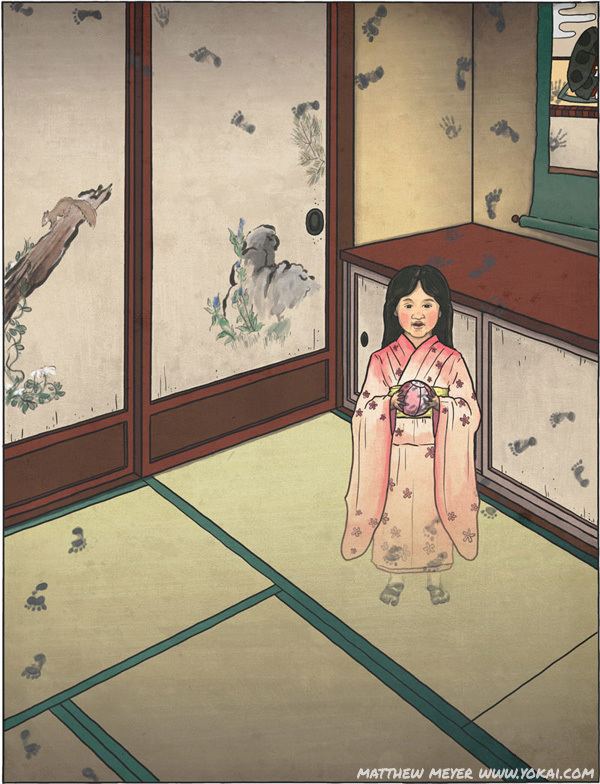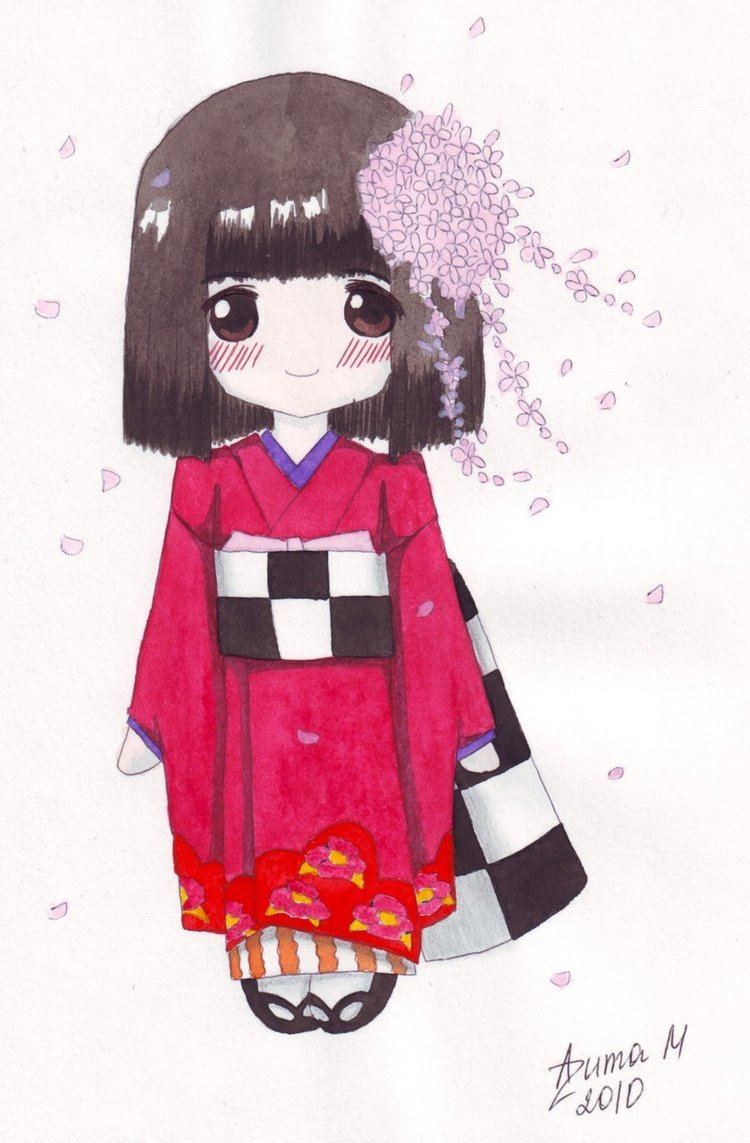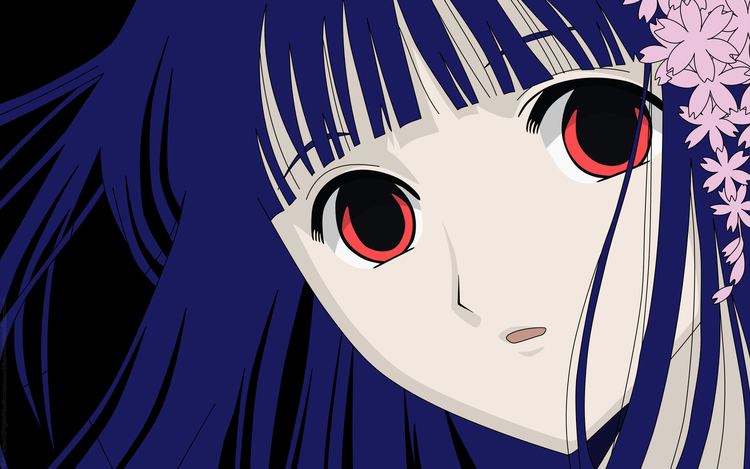Played by Aiko Hibi | ||
 | ||
Similar Yuki Onna, Futakuchi‑onna, Bakeneko, Jorōgumo, Akaname | ||
Zashiki-warashi (Japanese: 座敷童子 or 座敷童, literally "guestroom child"), sometimes also called Zashiki Bokko (Japanese: 座敷ぼっこ, literally "guestroom basker"), are spirit-like beings told about mostly in the Iwate Prefecture. They are said to be gods that live in zashiki or storage rooms, and they would perform pranks, and those that see one would be visited with good fortune. There are also legends of how they would bring fortune to families. They are also known from Kunio Yanagita's Tōno Monogatari, Ishigami Mondō, and stories about them appear in the 17th and 18th chapter of the Tōno Monogatari and the 87th chapter titled "Zashiki-warashi" of the Tōno Monogatari Shūi, and in this 17th chapter it is written "families with whom this god dwells are freely able to prosper at will" (kono kami no yadoritamafu ihe ha fūki jizai nari to ifu koto nari) and "zashiki-warashi are also called 座敷童衆." In recent years, they are also known from television programs and magazines that reported about varous Iwate Prefecture ryokan where it is said to be possible to see a zashiki-warashi such as the Ryokufūsō, the Sugawara Bekkan, and the Warabe.
Contents

It is similar to the Russian folk story of the Domovoi.
Concept

Reports have mostly been in the Iwate Prefecture, but there are also some scattered across the Aomori Prefecture, the Miyagi Prefecture, the Akita Prefecture, and others in the Tōhoku region.
Generally they have a red face, hair that hangs down, and have the appearance of that of a child about 5 or 6 in age, but this age is also said to vary depending on the house that they settle in, with examples ranging from a minimum of around 3 years in age and a maximum of around 15 years in age. They have a Bob cut hair or very short cropped hair. Both male and females ones have been seen, and the male ones are said to wear blackish clothes with a kasuri or striped pattern, and the females ones are said to wear a red chanchanko, kosode, and sometimes a furisode. It is also said that there are some whose appearance is unclear, making their gender unknown. Sometimes multiple would settle in a house at once, like a boy and a girl. There are also some legends that tell ones that look like a black beast, as well as ones that look like a warrior.
They like causing mischief, so they are said to leave ash or bleaching powder on top of little footprints and at night time, they are said to make sounds like that of a revolving spinning wheel, and they would also make sounds in an inner room making sounds like that of a kagura performance. There are also tales told about how when someone in the family is sewing alone, there would be sounds similar to the rustling of papers or someone snorting among others, and when the wooden door is opened there would be no one there. It is also said that at night, they would do pranks such as riding on top of guest room futons and turning over the pillows in order to not let the person sleep, and when attempts are made to stop it, it would be too strong and powerful for anyone to even affect its actions. Sometimes they also play with cihldren.
In Iwate, there are legends of how the aashiki-warashi of a shrine at Hayachine would follow a shrine visitor who came from afar and follow them into different lands. There is also legends of how the zashiki-warashi would teach the nursery rhyme of Iwate to the children of those lands.
In Gonohe, Aomori Prefecture, there is a legend of how when a new house is built, a zashiki-warashi can be called into it by burying a golden ball under the floors.
There are also theories about how they cannot be seen by anyone other than members of the family or how they can only be seen by children but not adults. There are stories about how when adults counted children, there would be 1 more person than there was originally, but as adults do not understand what zashiki-warashi are, they would not know who is the extra person. Stories like these also frequently appear as themes in literature.
Relation to family prosperity
An example of a very characteristic folk belief about how families with a zashiki-warashi would prosper and families whose zashiki-warashi have gone away would decline. This aspect shows that zashiki-warashi are like gods of fortune or protective spirits that rule over a family's prosperity and decline.
In the Tōno Monogatari, there are tales such as one telling about how a family was wiped out by foodborne illness after its zashiki-warashi left it and another tale aobut how in the Iide section of the village of Tsuchibuchi, Iwate Prefecture (now part of the city of Tōno), a wealthy family's zashiki-warashi was shot by a kid with a bow and arrow causing it to leave the family and since then the family's fortunes declined. There is also the view that the way families would decline after a zashiki-warashi leaves it and the way families would prosper after a binbōgami leaves it are related.
There is the theory that a white zashiki-warashi is a sign of good things to come and the sight of a red one (with a red face, red clothes, and a red bucket in its hands) is a sign that a zashiki-warashi would leave the family leading to bad things to come. There are also examples where a family that saw a red-clothed one all died from from foodborne illness.
Customs
Zashiki-warashi are there in inner guestrooms (zashiki), and their existence is said to have an effect on the direction the family goes in, so there are some families that treat them hospitably and offer them meals every day. They are said to like azuki meshi, so there are families that offer some azuki meshi every day, and if it is not eaten, it is said to be an open for the family's decline. Zashiki-warashi generally work the same way as having kitsune or having inugami, but the difference between them and zashiki-warashi is that for a zashiki-warashi to live there is never considered a nuisance, and in fact they are even protected as a gods, and a family that has a zashiki-warashi is usually treated by other people around with respect.
In the area around the city of Ninohe, there is a custom of making a room with desserts and toys left inside for a child who once passed away or were killed as infants, and giving worship to this child, a custom that remains to the present day, and there is also a custom of making a room that a child would like in order to make a zashiki-warashi stay at the house in order to bring the family to propserity.
According to the Tonō Monogatari, the house of a certain wealthy family in the town of Tsuchibushi had a small space that was called the "Zatō room," and it is considered to be the room that would be used to await the Zatō (a kind of member of the build persons' guild) every time a banquet was called in the past, but the literary researcher Sukeyuki Miura surmises that perhaps this room was used to give worship to the god's protective spirit.
Etymology
The name breaks down to zashiki (Japanese: 座敷), a sitting room or parlor, usually with tatami flooring, and warashi (Japanese: 童子), an archaic term for a child, used particularly in the northeast of Japan.
Description
The appearance of this spirit is that of a 5 or 6 year child with bobbed hair and a red face. Zashiki warashi can be found in well-maintained and preferably large old houses. It is said that once a zashiki warashi inhabits a house, it brings the residence great fortune; on the other hand, should a zashiki warashi depart, the domain soon falls into a steep decline.
As the zashiki warashi is child-like in nature, it is prone to playing harmless pranks and occasionally causing mischief. They are known for running around and making noise, even adjusting the bedding of overnight guests. Sometimes they leave little footsteps in ashes. There are different variations as to who can see the zashiki warashi; usually this is limited to inhabitants of the house, sometimes to children.
Yōkai similar to zashiki warashi in other parts of Japan include: the makuragaeshi in Ishikawa Prefecture - another creature which alters bedding; the ainukaisei in Hokkaido; and the akagantā found in Okinawa.
The Ryokufūsō in Kindaichi-Onsen, which burned down on October 4, 2009, was famed for its zashiki warashi.
